
塑料表面體積電阻率測量儀 標準配置:
1,測試儀器:1臺
2,電源線:1條
3,測量線:3根(屏蔽線,測試接線,接地線)
4,使用說明書:1份
注:本儀器配不同的測量電極(夾具)可以測量不同材料不(固體、粉體或液體)的體積電阻率和表面電阻率或電導率
塑料表面體積電阻率測量儀 技術要求
01電阻測量范圍1?104Ω ~1?1018 Ω
02電流測量范圍2?10-4A ~1?10-16A
03顯 示 方 式數字液晶顯示
04內置測試電壓10V 、50V、100V、250、500、1000V(任意切換)
05基本準確度1% (*注)
06使用環境溫度:0℃~40℃,相對濕度<80%
07供電形式AC 220V,50HZ,功耗約5W
08儀器尺寸285mm? 245mm? 120 mm
09儀器質量約5KG
10儀器可連續工作 8 小時
典型應用
1、測量絕緣材料電阻(率)
2、測量防靜電材料的電阻及電阻率
3、測量計算機房用活動地板的系統電阻值
4、測量防靜電鞋、導電鞋的電阻值
5、光電二極管暗電流測量
6、物理,光學和材料研究
應用范圍:
a 材料高阻測試測量如防靜電產品(防靜電鞋、防靜電塑料橡膠制品、計 算機房防靜電活動地板等)電阻值的檢測;
b 材料體積電阻(率)和表面電阻(率)測量;
c 電化學和材料測試,以及物理,光學和材料研究;
d 微弱電流測量如光電效應和器件暗電流測量。
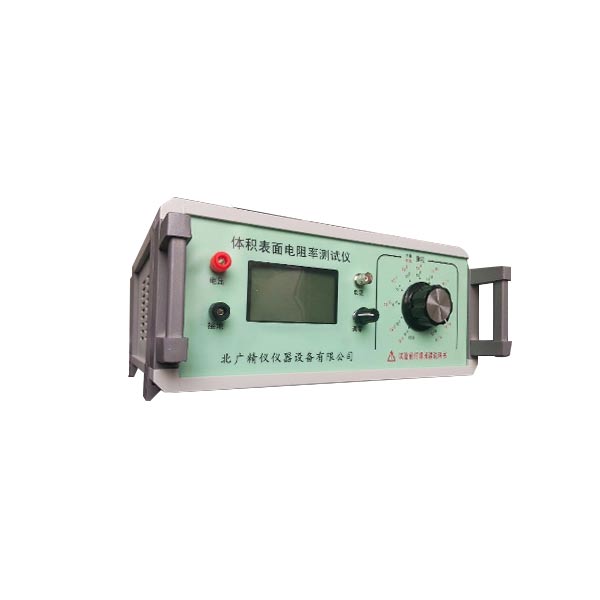
使用說明
(一)應滿足下例要求:
1、測試電壓范圍應包括:100V~500V
2、測量范圍應包括:1?106Ω~1?1017Ω
3、阻值大于1012Ω時,測量誤差應小于?20%,阻值不大于1012Ω時,測量誤差應小于?10%。
4、輸入接線的絕緣電阻應大于儀器輸入電阻的100倍。
5、測試時試樣及測量導線應有良好。
6、儀器應定期進行校驗。
(二)準備工作:
1、取被測液體(如:增塑劑)試樣50ml。
2、試樣應在溫度23?2℃,相對濕度65?5%的條件下處理2小時以上。
(三)測試步驟:
1、測試溫度23?2℃,相對濕度65?5%,無外界電磁場干擾環境中進行。
2、測試時對試樣所加電壓為100V~500V的直流電壓,選擇電壓檔次。
3、將試樣倒入高壓電極內,使液面剛好和環電極下緣全部接觸為止。
4、將充分放電后的試樣和電極,按固體(液體)體積及表面電阻率測試儀要求接線。
外電極(高壓電極)接高固體(液體)體積及表面電阻率測試儀的高壓輸出端。
內電極(測量電極)接固體(液體)體積及表面電阻率測試儀的測量端。
中電極(環電極)接固體(液體)體積及表面電阻率測試儀的接地端。
5、儀器預熱30分鐘,穩定后調整儀器(調零),加上試驗1分鐘,讀取電阻指示值,然后放電1分鐘,再測試一次,以二次的算術平均值作為試驗樣品電阻指示值。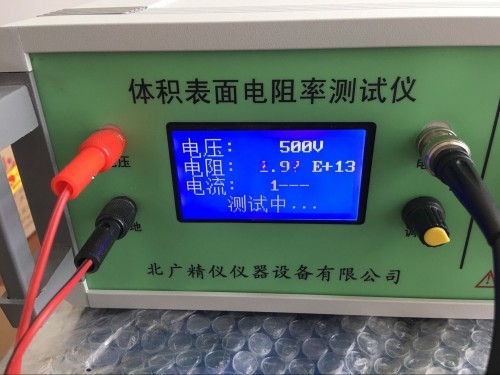
(四)計算方法:
按式(1)計算體積電阻系數(pv),計算結果取二位有效數字。
(五)注意事項:
1、測定電極必須放置在高絕緣的墊板上。
2、測定電極在測試前后,均應做好清洗工作,特別是三只電極的支撐件不得受到試樣的污染
使用注意事項
高阻測量一定要嚴格按使用方法步聚進行,否則有可能造成儀器永久損壞或電人。
1 應在“Rx”兩端開路時調零(主機開機)
如接在電阻箱或被測量物體上時調零后測量會產生很大的誤差。一般一次調零后在測試過程中不需再調零,但改變測量電壓后可能要重新調零。
2 禁止將“Rx”兩端短路,以免微電流放大器受大電流沖擊
3 在測試過程中不要隨意改動測量電壓,
隨意改動測量電壓可能因電壓的過高或電流過大損壞被測試器件或測試儀器,而且有的材料是非線性的,即電壓與電流是不符合歐姆定律,有改變電壓時由于電流不是線性變化,所以測量的電阻也會變化。
4 測量時從低次檔逐漸拔往高次檔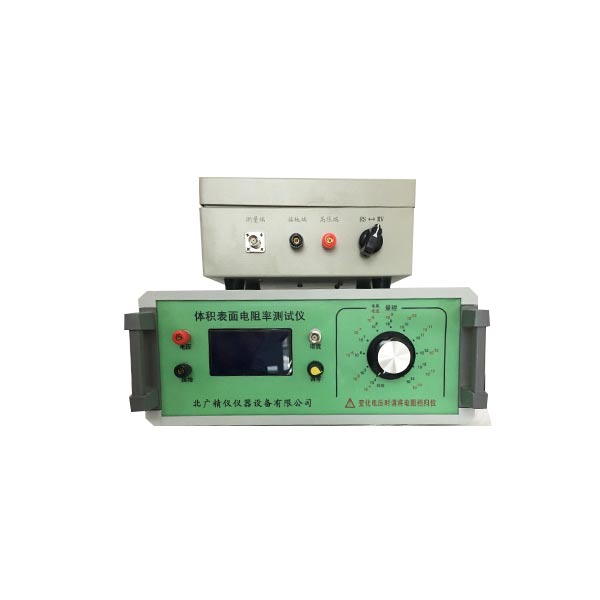
每撥一次稍停留1~2秒以便觀察顯示數字,當有顯示值時應停下,記錄當前的數字即是被測電阻值。若顯示“1”時,表示欠量程應往高次檔拔。直到有顯示數字時為止。當有顯示數字時不能再往高次檔撥,否則有可能損壞儀器(機內有過電流保護電路)。除104 Ω檔之外,當顯示低于1.99,表示過量程應換低檔!
5 大部分絕緣材料,特別是防靜電材料的電阻值在加電壓后會有一定變化而引起數字變化
由于本儀器的分辯率很高,因而會引起顯示值的末尾幾位數也變化,這不是儀器本身的問題,而是被測量對象的導電機理復雜而使得阻值有些變化。在這種情況下往往取2位有效數就夠了。
6 接通電源后,手指不能觸及高壓線的金屬部分
本儀表有二連根線:高壓線(紅)和微電流測試線。在使用時要注意高壓線,開機后人不能觸及高壓線,以免電人或麻手。
7 測試過程中不能觸摸微電流測試端
微電流測試端最怕受到大電流或人體感應電壓及靜電的沖擊。所以在開機后和測試過程中不能與微電流測試端接觸,以免損壞儀表。
8 在測量高阻時,應采用屏蔽盒將被測物體屏蔽.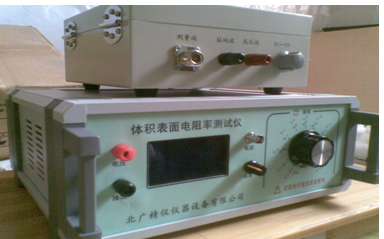
在測量大于1010 Ω以上時,為防止外界干擾面而引起讀數不穩。
9 每次測量完時應將量程開關撥回“104 ”檔再進行下次測試
在測量時應逐漸將量程開關撥到高阻檔,測量完時應將電流電阻量程、電壓量程開關撥回低檔。以確保下次開機時量程開關處在低阻量程檔。
Standard configuration:
1. Testing instrument: 1 unit
2. Power cord: 1
3. Measurement wires: 3 wires (shielded wire, test wire, grounding wire)
4. User manual: 1 copy
Note: This instrument, equipped with different measuring electrodes (fixtures), can measure the volume resistivity, surface resistivity, or conductivity of different materials (solid, powder, or liquid)
technical requirement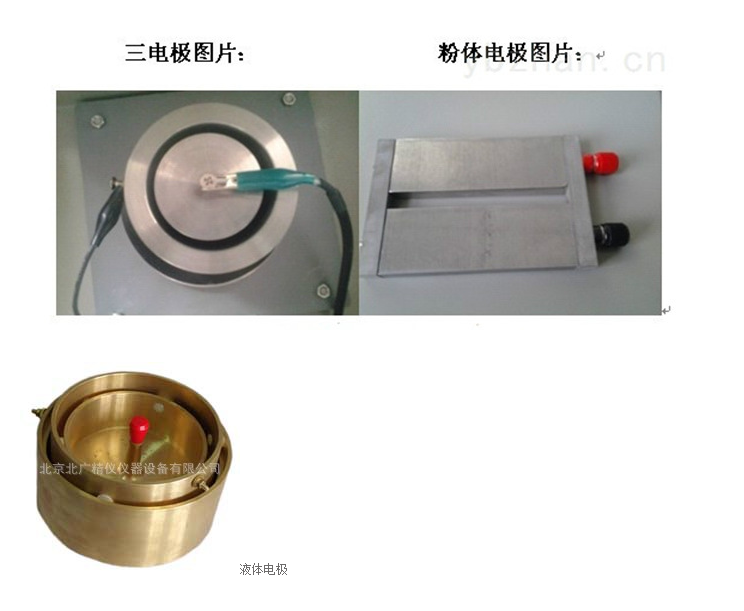
01 Resistance measurement range 1 ? 104 Ω~1 ? 1018 Ω
02 Current measurement range 2 ? 10-4A~1 ? 10-16A
03 Display Method: Digital LCD Display
04 Built in test voltage: 10V, 50V, 100V, 250, 500, 1000V (can be switched freely)
05 Basic accuracy 1% (* note)
06 Operating environment temperature: 0 ℃~40 ℃, relative humidity<80%
07 Power supply form AC 220V, 50HZ, power consumption about 5W
Instrument size: 285mm ? 245mm ? 120mm
The quality of the 09 instrument is about 5KG
10 instruments can work continuously for 8 hours
Typical applications
1. Measure the resistance (rate) of insulation materials
2. Measure the resistance and resistivity of anti-static materials
3. Measure the system resistance value of the raised floor used in the computer room
4. Measure the resistance value of anti-static shoes and conductive shoes
5. Measurement of Dark Current in Photodiodes
6. Physics, Optics, and Materials Research
Application scope:
A material high resistance test measurement, such as detecting the resistance value of anti-static products (anti-static shoes, anti-static plastic rubber products, computer room anti-static raised floor, etc.);
Measurement of material volume resistance (rate) and surface resistance (rate);
Electrochemical and material testing, as well as physics, optics, and materials research;
Weak current measurement such as photoelectric effect and device dark current measurement.
instructions
(1)The following requirements should be met:
1. The testing voltage range should include: 100V~500V
2. The measurement range should include: 1 ? 106 Ω~1 ? 1017 Ω
3. When the resistance value is greater than 1012 Ω, the measurement error should be less than ? 20%, and when the resistance value is not greater than 1012 Ω, the measurement error should be less than ? 10%.
4. The insulation resistance of the input wiring should be greater than 100 times the input resistance of the instrument.
5. The sample and measuring wire should be in good condition during testing.
6. The instrument should be calibrated regularly.
(2)Preparation work:
1. Take 50ml of the tested liquid (such as plasticizer) sample.
2. The sample should be treated for more than 2 hours under the conditions of a temperature of 23 ? 2 ℃ and a relative humidity of 65 ? 5%.
(3)Test steps:
1. The test is conducted in an environment with a temperature of 23 ? 2 ℃, a relative humidity of 65 ? 5%, and no external electromagnetic field interference.
2. When testing, apply a DC voltage of 100V~500V to the sample and select the voltage level.
3. Pour the sample into the high-voltage electrode until the liquid level is in full contact with the lower edge of the ring electrode.
4. Connect the fully discharged sample and electrode according to the requirements of the solid (liquid) volume and surface resistivity tester.
Connect the external electrode (high-voltage electrode) to the high-voltage output terminal of the high solid (liquid) volume and surface resistivity tester.
The inner electrode (measuring electrode) is connected to the measuring end of the solid (liquid) volume and surface resistivity tester.
Connect the middle electrode (ring electrode) to the grounding terminal of the solid (liquid) volume and surface resistivity tester.
5. Preheat the instrument for 30 minutes, adjust the instrument (zero) after stabilization, add 1 minute of test, read the resistance indication value, discharge for 1 minute, and then test again, taking the arithmetic mean of the two times as the resistance indication value of the test sample.
(4)Calculation method:
Calculate the volume resistance coefficient (pv) according to equation (1), and take the two significant digits of the calculation result.
(5)Attention:
1. The measuring electrode must be placed on a highly insulated pad.
2. Before and after testing, the electrodes should be cleaned properly, especially the supporting parts of the three electrodes should not be contaminated by the sample
Precautions for use
High resistance measurement must be strictly carried out according to the usage method steps, otherwise it may cause permanent damage to the instrument or electric shock.
1. Zero should be adjusted when the "Rx" ends are open circuited (when the host is turned on)
If connected to a resistance box or the object being measured, zeroing the measurement will result in significant errors. Generally, after one zeroing, there is no need to zero again during the testing process, but resetting may be necessary after changing the measured voltage.
2. It is prohibited to short-circuit the "Rx" terminals to prevent the microcurrent amplifier from being impacted by high currents
Do not arbitrarily change the measured voltage during the testing process,
Randomly changing the measured voltage may damage the tested device or instrument due to excessive voltage or current, and some materials are nonlinear, meaning that voltage and current do not conform to Ohm's law. When changing the voltage, the measured resistance will also change because the current does not change linearly.
During measurement, gradually shift from low gear to high gear
Pause for 1-2 seconds each time to observe the displayed number. When there is a display value, stop and record the current number as the measured resistance value. If "1" is displayed, it indicates that the underrange should be shifted to higher gears. Until there are displayed numbers. When there are displayed numbers, do not dial to higher gears, otherwise it may damage the instrument (there is an overcurrent protection circuit inside the machine). Except for the 104 Ω gear, when the display is below 1.99, it indicates that the overtravel should be shifted to a lower gear!
The resistance value of most insulation materials, especially anti-static materials, will change to some extent after applying voltage, causing numerical changes
Due to the high resolution of this instrument, the last few digits of the displayed value may also change. This is not a problem with the instrument itself, but rather due to the complex conductivity mechanism of the measured object, which causes some changes in the resistance value. In this case, taking 2 significant digits is often sufficient.
After connecting the power supply, fingers should not touch the metal part of the high-voltage line
This instrument has two connecting wires: the high-voltage wire (red) and the microcurrent testing wire. When using, pay attention to the high-voltage wires. After turning on the machine, do not touch the high-voltage wires to avoid electric shock or numbness.
During the testing process, do not touch the microcurrent testing terminal
The microcurrent testing end is most afraid of being impacted by high currents, human induced voltages, and static electricity. Therefore, it is not allowed to come into contact with the microcurrent testing terminal after startup and during testing to avoid damaging the instrument.
When measuring high resistance, a shielding box should be used to shield the object being measured
To prevent unstable readings caused by external interference when measuring above 1010 Ω.
After each measurement, the range switch should be turned back to the "104" position before conducting the next test
During measurement, the range switch should be gradually turned to the high resistance range. After measurement, the current resistance range and voltage range switches should be turned back to the low range. To ensure that the range switch is in the low resistance range range mode during the next startup.
北廣精儀公司電性能及橡膠塑料相關產品:
BWN拉力材料試驗機(符合國標GB/T1172-1999、GB/T2975-1998、GB/T10632-1989)
BDJC-10KV-200KV電壓擊穿試驗儀(符合國標GB1408-2006、GB/T1695-2005、GB/T3333、HG/T 3330、GB12656、ASTM D149)
BEST-121體積表面電阻率測定儀(符合國標GB/T 1410、2439、10581、1692、12703.4、10064、ASTM D257-99)
BQYH-96塑料球壓痕硬度計(符合國標GB/T3398-2008)
BEST-19導體材料電阻率測試儀
M-200橡膠塑料滑動摩擦試驗機(國標,非國標,可定制)
GDAT-A介電常數介質損耗測試儀(可測試固體液體
BQS-37A高頻介電常數介質損耗測試儀
BDH-20KV絕緣材料耐電弧性能試驗儀/高電壓小電流測試儀
BWK-300A液顯熱變形維卡軟化點溫度測定儀
BQYH-96塑料球壓痕硬度計
BRT-400Z熔體流動速率測定儀/熔融指數儀
BMD-A計算機控制馬丁耐
HMYX-2000海綿泡沫壓陷硬度測定儀
HMLQ-500海綿泡沫落球回彈儀
HMPL-2000海綿泡沫疲勞沖擊測定儀
HMLS-1000海綿拉伸強度試驗機
HMYS-200海綿壓縮永久變形試驗機
HMMD-A海綿密度測定儀
JF-3氧指數測定儀
XCY-III低溫脆性試驗機
BLD-600V漏電起痕試驗儀
BLD-6000V高壓漏電起痕試驗儀
BLC-2000落球沖擊試驗機
BLB-30管材落鏢沖擊試驗機
BCM-03擺錘薄膜沖擊試驗機
CZF-5水平垂直燃燒試驗儀
BZR-A汽車內飾材料阻燃性能試驗機
BYL-01啞鈴制樣機
BJ-50簡支梁沖擊試驗機
BX-50懸臂梁沖擊試驗機
BM-201門尼粘度試驗機
BL-200無轉子硫化儀
cp-s沖片機手動
cp-q氣動沖片機
業務咨詢:932174181 媒體合作:2279387437 24小時服務熱線:15136468001 盤古機械網 - 全面、科學的機械行業免費發布信息網站 Copyright 2017 PGJXO.COM 豫ICP備12019803號